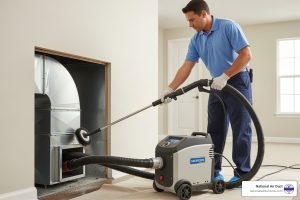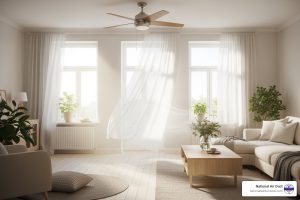Why Commercial Buildings Need Advanced Air Quality Solutions
Germicidal UV light HVAC systems are essential for commercial buildings, linking air quality directly to the bottom line. With indoor air up to 5 times more polluted than outdoor air and employees spending nearly 2,000 hours annually indoors, the stakes are high.
Quick Overview: Germicidal UV Light HVAC Systems
- Technology: UV-C light (254 nm wavelength) disrupts DNA/RNA of microorganisms
- Effectiveness: Kills up to 99.99% of bacteria, viruses, and mold
- Applications: Coil irradiation, air-stream disinfection, surface treatment
- Benefits: Improved HVAC efficiency, better indoor air quality, reduced sick days
- Cost: $1,000-$2,000 for quality commercial systems
- Maintenance: Lamp replacement every 1-5 years
- Safety: Professional installation required to avoid direct UV exposure
The numbers are compelling: studies show UV lights can reduce mold and bacteria by 97% in test environments and restore HVAC system capacity by up to 35%. This translates to lower energy costs, fewer maintenance calls, and healthier, more productive employees.
The COVID-19 pandemic renewed interest in this established technology, as organizations saw clean air as vital for business continuity. ASHRAE confirms that UV-C inactivates nearly all microorganisms on HVAC surfaces with up to 99% kill ratios.
A key benefit many miss is that UV-C systems work continuously, even when the HVAC is off. Unlike filters that only trap particles, germicidal UV light actively destroys pathogens.
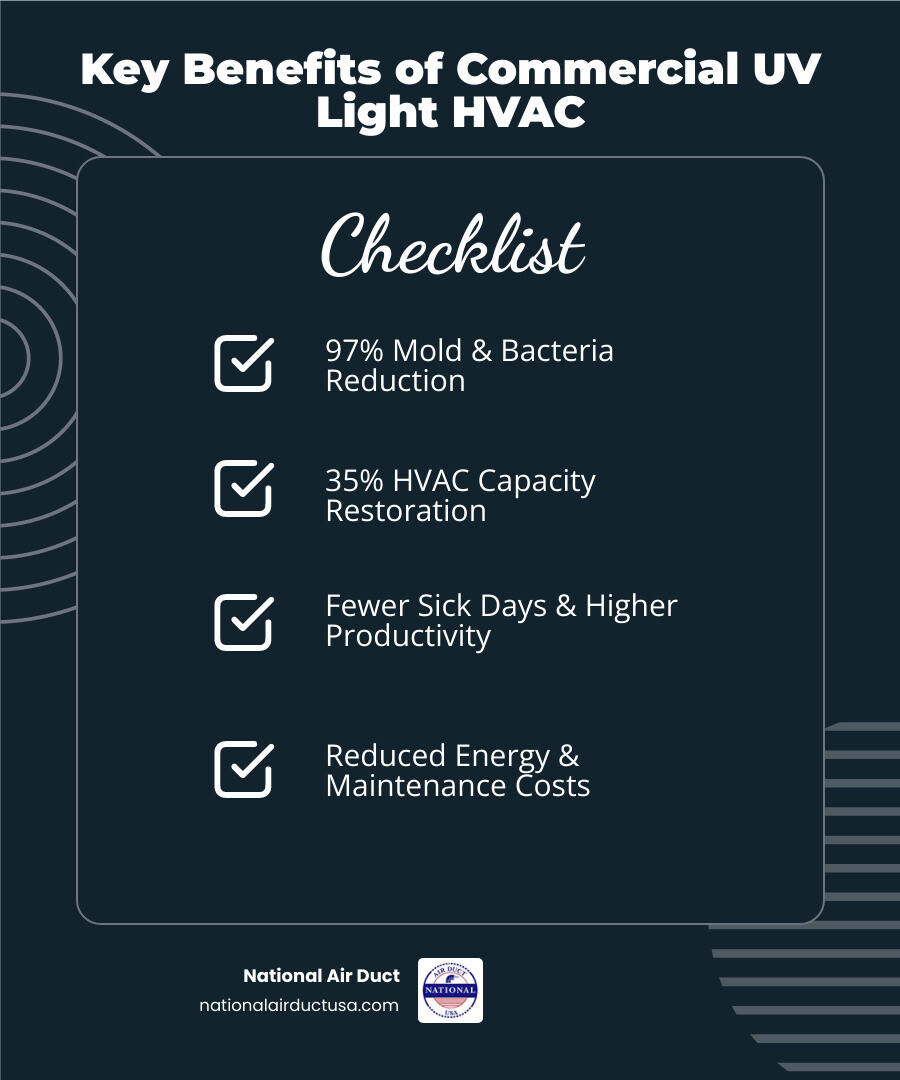
How Germicidal UV Light for HVAC Systems Works
Germicidal UV light HVAC systems use a specific type of light that has been a proven disinfection tool for over a century. Understanding how it works reveals why it’s a critical component for any modern commercial building.
The Science of UV-C Disinfection
The technology uses ultraviolet-C (UV-C) light, which operates between 200 and 280 nanometers, with the peak germicidal wavelength at 254 nanometers. This is different from the UVA and UVB light from the sun.
UV-C light damages the DNA and RNA of microorganisms like bacteria, viruses, and mold. This permanent damage prevents them from reproducing, rendering them harmless. It’s a simple and powerful method of neutralization.
This technology is over a century old. Scientists finded UV-C’s germ-killing abilities long ago, and it has been used by hospitals to fight tuberculosis and by water treatment plants to ensure safe drinking water for decades. Impressively, no microorganism tested to date has proven resistant to UV-C when applied with the correct dose. You can dive deeper into the scientific research on UVGI effectiveness for detailed studies.

Key Technologies and System Types
We strategically install germicidal UV light HVAC systems in commercial buildings for maximum effect.
Coil irradiation is our most popular approach. We install UV-C lamps over evaporator coils and drain pans—cool, damp, dark areas where mold and bacteria thrive. This continuous UV-C exposure prevents microbial growth, leading to cleaner coils, better airflow, and lower energy bills.
Air-stream disinfection involves placing UV-C lamps in the ductwork or air handling unit to treat air as it circulates. This process zaps airborne viruses and mold spores, preventing them from reaching occupied spaces.
Upper-room UVGI is a specialized option, mainly for healthcare settings, where fixtures direct UV-C light across the upper portion of a room to clean air as it circulates naturally.
Most systems use efficient low-pressure mercury lamps that produce the ideal 254-nanometer wavelength. LED UV-C technology is also emerging, offering longer lifespans.
Industry Endorsements and Standards
The effectiveness of germicidal UV light HVAC systems is backed by leading industry organizations.
ASHRAE (the American Society of Heating, Refrigerating and Air-Conditioning Engineers) has long endorsed UV-C, recognizing its ability to eliminate nearly all microorganisms on HVAC surfaces with up to 99% kill rates. Their handbooks provide specific guidance, establishing it as a cornerstone of modern IAQ. ASHRAE’s stance on filtration and disinfection confirms this.
The CDC also recommends germicidal UV for reducing the transmission of airborne diseases, particularly in healthcare settings.
As NADCA-certified professionals, we know UV-C’s role in air quality. NADCA’s position is that while UV-C doesn’t physically clean the system (our professional clean ventilation system services do that), it is highly effective at reducing airborne pathogens when properly installed and maintained. Proper installation is essential for achieving these results.
The ROI of UV-C: Boosting Your Bottom Line and Building Health
Investing in a germicidal UV light HVAC system for your commercial building pays dividends in multiple ways, from monthly utility bills to employee productivity.
Improved HVAC Efficiency and Longevity
One of the biggest benefits of UV-C lights is their work inside your HVAC equipment. They act like invisible janitors, keeping internal components spotless around the clock.
Clean coils are efficient coils. Mold and biofilm buildup on evaporator coils forces your system to work overtime. UV-C lights prevent this, which can restore your system’s capacity by up to 35%—a significant upgrade without new equipment.
This efficiency boost leads directly to reduced energy consumption, lowering your monthly utility bills. You’ll also see lower maintenance costs, as clean components mean fewer service calls and less wear on expensive parts.
Most importantly, UV-C lights help extend your equipment’s lifespan. A smoothly running system experiences less stress on its components, delaying costly replacements. To learn more about amplifying these benefits, see our guide on keeping your ventilation system clean.
Superior Indoor Air Quality (IAQ) and Occupant Well-being
The health and productivity benefits of circulating cleaner air are remarkable and measurable.
UV-C excels at pathogen reduction. Research shows it can reduce mold and bacteria by 97% and airborne flu viruses by 90%. This means fewer illness-causing microorganisms for your employees and visitors.
These systems provide comprehensive mold and bacteria control at the source, stopping them before they can spread. You’ll also notice odor neutralization as UV lights break down volatile organic compounds (VOCs), making the indoor environment fresher.
For those with allergies or asthma, allergen reduction can be life-changing. UV-C inactivates biological allergens like mold spores that may pass through filters.
The bottom-line impact is improved employee productivity and reduced sick days. Poor IAQ causes headaches and fatigue. Cleaner air helps employees feel better, think clearer, and take less time off, directly boosting your bottom line.
Protecting Your Investment and Reputation
Installing a germicidal UV light HVAC system sends a powerful message about your commitment to a healthy facility.
Preventing “sick building syndrome” protects both your occupants and your reputation by creating an environment where people want to spend time. In today’s health-conscious world, demonstrating your commitment to health is essential. UV-C systems show employees and clients you take their well-being seriously, building trust and providing a competitive advantage.
Finally, you’re enhancing your property value. Buildings with modern air quality solutions are more attractive to tenants and buyers, signaling professional management and a commitment to occupant satisfaction.
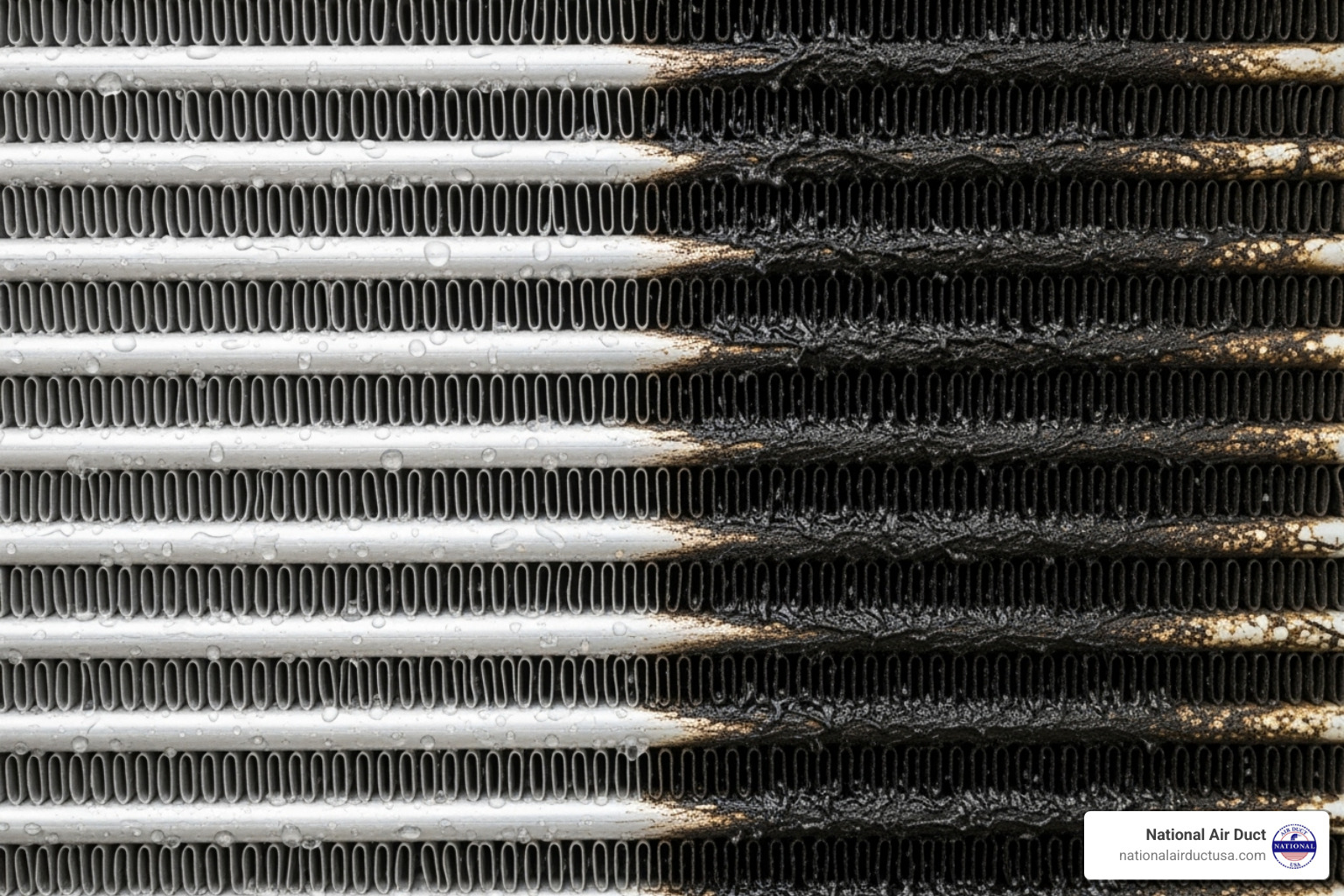
Practical Implementation: Installation, Costs, and Safety
Once you’re convinced a germicidal UV light HVAC system is right for your building, it’s time to consider the practical details of installation, cost, and safety.
Strategic Installation of a Germicidal UV Light HVAC System
UV-C installation is not a DIY job. The system’s effectiveness depends on precise placement, which requires professional expertise.
Air handler placement is ideal for coil irradiation, with lamps installed over evaporator coils and drain pans where mold and bacteria breed. For air-stream disinfection, ductwork installation is more complex, requiring lamps to be positioned for sufficient air exposure time.
Commercial systems are far more complex than residential ones due to larger air volumes and intricate ductwork. Lamp quantity, intensity, and placement must be calculated for your specific system.
Professional installation is crucial for effectiveness (correct placement and power), safety (preventing direct UV-C exposure to skin and eyes), and system protection (shielding vulnerable materials like plastics or rubber from degradation).
Understanding the Costs and Maintenance
Let’s break down the numbers for a commercial system.
The upfront investment for a quality commercial germicidal UV light HVAC system typically costs $1,000 to $2,000. This price reflects a comprehensive system designed for commercial use, with the final cost depending on your HVAC system’s size and the number of lamps needed.
Installation costs are usually included in the investment when working with professionals.
Ongoing maintenance involves lamp replacement. Most UV-C lamps need to be replaced every one to five years, depending on the technology. Their germicidal output decreases over time, even if the lamp still glows.
Energy consumption is minimal, typically 15 to 100 watts, which is negligible compared to the energy savings from improved HVAC efficiency.
Factors affecting your total investment include HVAC size, lamp quantity and type, installation location, labor, and ongoing lamp replacements.
Safety Protocols and Potential Drawbacks
Safety is absolutely critical with UV-C systems.
Direct exposure to UV-C radiation causes severe skin burns and painful eye inflammation. For this reason, lamps are always enclosed within the HVAC system, away from human contact.
We only use ozone-free lamps that emit at 254 nanometers, avoiding the respiratory irritation that ozone-producing lamps can cause.
Material degradation is a consideration, as prolonged UV-C exposure can harm materials like plastics or rubber. Professional installers know how to shield vulnerable components.
Our certified technicians follow strict safety protocols, including using lockout procedures, wearing UV-blocking protective gear, and following specific cleanup procedures for damaged lamps.
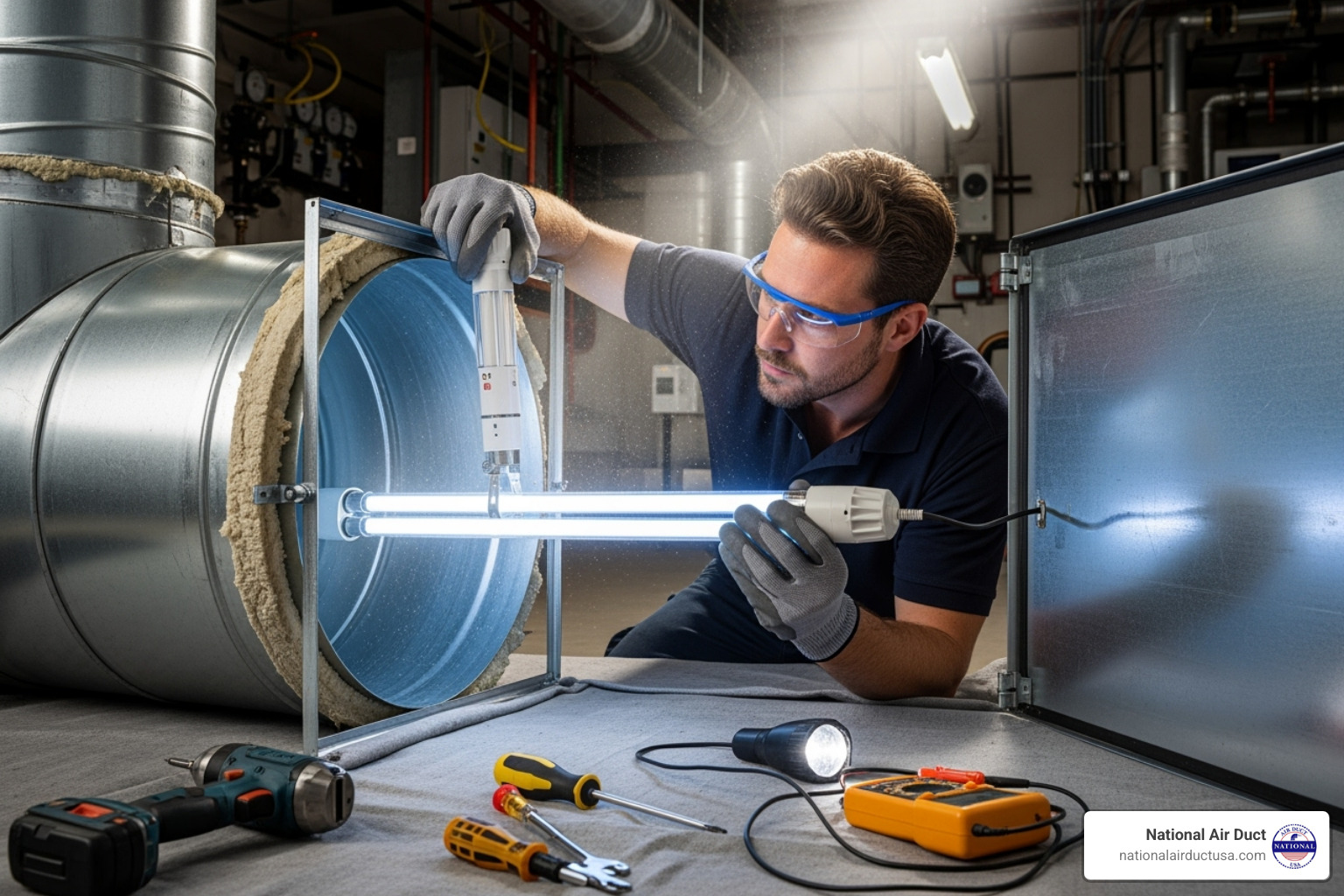
The bottom line is that germicidal UV light HVAC systems are incredibly effective and safe when installed and maintained by certified professionals.
UV-C and Integrated IAQ Solutions: A Comparative Look
For the healthiest commercial spaces, germicidal UV light HVAC systems work best as part of a multi-layered defense for your building’s indoor air quality.
UV-C Systems and High-Efficiency Filters (MERV/HEPA)
Facility managers often weigh UV-C lights against high-efficiency filters (MERV 13/HEPA). The good news is you don’t have to choose. They are perfect partners, each addressing different air quality aspects.
High-efficiency filters act like bouncers, physically trapping particles like dust, pollen, and some bacteria. They excel at removing particulate matter from the air.
UV-C lights are like specialized security guards, neutralizing threats on contact. They don’t remove particles but instead scramble the DNA of bacteria, viruses, and mold spores, rendering them harmless. This is especially effective against tiny pathogens that might slip past filters.
When combined, filters trap particles and protect UV lamps from dust, while the germicidal UV light HVAC system neutralizes any pathogens that get past the filter or grow on HVAC surfaces. This one-two punch creates far cleaner air than either technology could alone. For more on how these technologies work together, learn about disinfecting your HVAC system.
Why UV-C is a Preferred Choice for Commercial IAQ
UV-C technology stands out for several compelling reasons in commercial environments.
Direct microbial inactivation is its superpower. It physically damages the DNA and RNA of microorganisms for immediate neutralization.
No harmful byproducts are produced when properly installed with ozone-free 254 nm lamps, making it a clean choice for continuous operation.
Lower maintenance is another key benefit. Lamps need replacement every 1-5 years, which is often less frequent than other technologies. By keeping coils clean, UV-C also reduces other maintenance tasks.
Here’s how UV-C compares to high-efficiency filtration:
| Feature | UV-C Light | High-Efficiency Filtration (MERV/HEPA) |
|---|---|---|
| Primary Action | Inactivates/kills microorganisms (viruses, bacteria, mold) | Physically captures particles (dust, pollen, mold spores, some microbes) |
| Effectiveness | Highly effective against biological contaminants; continuous disinfection | Highly effective against particulate matter; removes airborne debris |
| Cost | Moderate upfront, low energy, moderate lamp replacement | Moderate upfront, higher energy (due to pressure drop), regular filter replacement |
| Maintenance | Lamp replacement (1-5 years); occasional lamp cleaning | Regular filter replacement (monthly to annually) |
| Byproducts | None (with ozone-free lamps) | None (physical capture) |
| Best For | Pathogen control, coil sanitation, odor reduction | Particulate removal, allergen reduction |
UV-C technology offers a reliable, low-maintenance way to actively fight pathogens while complementing your existing filtration systems.
Frequently Asked Questions about Commercial HVAC UV Lights
As experts in germicidal UV light HVAC systems, we often hear the same thoughtful questions from commercial clients. Here are the answers to the most common ones.
How effective are UV-C lights against viruses like the flu or coronaviruses?
UV-C lights are highly effective against viruses, including those that cause the flu and coronaviruses. The technology works universally by attacking the fundamental DNA and RNA of these pathogens, scrambling their genetic material so they cannot reproduce or cause infection.
Studies have shown that UV light air purifiers can reduce airborne flu virus by 90%. While research continues on specific strains, UV-C has proven effective against similar coronaviruses like SARS and MERS. The key is a properly designed germicidal UV light HVAC system that ensures pathogens receive a sufficient dose of UV-C as air circulates.
Will UV lights eliminate the need for regular duct cleaning?
No, absolutely not. This is a common misconception. As NADCA-certified professionals, we must be clear about what UV-C can and cannot do.
UV lights inactivate microorganisms like bacteria and viruses, but they do not remove physical contaminants like dust, debris, and dirt from your ductwork. NADCA’s position is that source removal of contaminants—professional duct cleaning—remains the best method for decontaminating HVAC systems.
Your germicidal UV light HVAC system is an excellent teammate for regular duct cleaning, not a replacement. A clean system allows air to flow efficiently and ensures UV light can effectively reach and neutralize microorganisms. Clean ducts plus UV disinfection is the ultimate combination for superior indoor air quality.
What is the typical lifespan of a commercial-grade germicidal UV light HVAC lamp?
The lifespan of commercial-grade germicidal UV light HVAC lamps typically ranges from 1 to 5 years. The exact duration depends on the technology and manufacturer.
Standard UV-C lamps may need annual replacement, while more advanced amalgam or LED UV-C systems can last 2 to 5 years. Operating conditions and run-time hours also play a role.
Crucially, don’t wait for the lamp to burn out. Its germicidal effectiveness declines long before the light goes out. Adhering to the manufacturer’s replacement schedule is essential for continued performance. As part of our maintenance checks, our technicians monitor and replace these lamps to ensure your system delivers optimal air purification.
Conclusion: A Clearer, Healthier Future for Your Facility
The future of commercial building management is clear: indoor air quality is integral to your business success. Investing in a germicidal UV light HVAC system is a smart decision with far-reaching benefits.
Your HVAC system works around the clock; make it work smarter. UV-C technology provides continuous air purification by destroying pathogens as your system runs, acting as a tireless guard for your building’s air quality.
The operational savings are significant. Cleaner coils lead to lower energy bills, longer equipment life, and fewer maintenance calls. At the same time, your employees benefit from a healthier environment, resulting in fewer sick days and better productivity.
What matters most is the health of your occupants. A germicidal UV light HVAC system ensures that employees and clients can feel confident they are breathing clean air, helping you deliver on that promise. The system longevity benefits also protect your significant HVAC investment for years to come.
At National Air Duct USA, our NADCA-certified expertise ensures every installation is planned and executed professionally for maximum effectiveness. We know that a truly healthy building starts with a clean foundation, which is why we emphasize combining UV-C technology with our professional air duct cleaning services for a comprehensive IAQ strategy.
Don’t let invisible threats compromise your building’s health or your bottom line. The technology is proven, and the benefits are real.
Schedule your professional UV light installation today and let us help you shine a light on a cleaner, healthier future for your facility.


